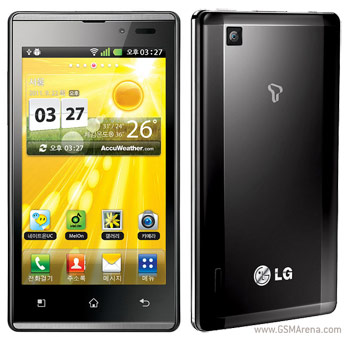
LG has just officially unveiled its Korea-bound Optimus EX smartphone. We first met with the Android-running handset last week, when we got an official photo and detailed specs ahead of teh launch, so there are no surprises now.
The LG Optimus EX runs on Gingerbread and relies on a Tegra 2 chipset with a 1.2 GHz dual-core CPU and 1GB of RAM to do the math. The 4" WVGA screen on top will be of the NOVA variety, which promises one of the highest brightness levels on the market.
At the back there's a 5 megapixel camera that does 1080p video recording, while on the front is a VGA camera for video-chatting. The included storage is relatively modest at 8GB, but the microSD slot lets you expand that as much as you like.
The LG SU880 Optimus EX will be available to South Korea's SK Telecom customers, but the release timeframe or pricing haven't been mentioned. LG also hasn't mentioned if they plan on bringing a version of the smartphone to Europe or US
LG Optimus Hub
LG Optimus SOL E730
Sol means sun in Spanish and the name is given to describe the Ultra AMOLED display — which the users would be easily able to view in direct sunlight as well.

LG has officially unveiled the LG Optimus Sol, also called E730, which is named after the Spanish word for sun. The phone has been given this name for a purpose - it comes with 3.8-inch WVGA (Wide Video Graphics Array) "Ultra AMOLED" (Active-Matrix Organic Light-Emitting Diode) display, which the users would be easily able to view in direct sunlight as well.
The phone uses 1 GHz central processing unit (CPU), a five megapixel camera, Android Gingerbread and is 9.8 mm thick. The LG Optimus Sol would be released in Europe by mid-September and then would be launched in Central and South America. It would be available in titan, black and white colours.
"The Optimus Sol stands out from its competitors as the most affordable 1 GHz Android smartphone with an AMOLED display," said Dr Jong-seok Park, president and chief executive officer, LG Electronics Mobile Communications Company. "By introducing a no nonsense phone that boasts one of the best displays on the market, we think we have a real winner for consumers looking for a subtle but visually stunning phone."
The LG Optimus Sol has a different kind of power management system which improves the battery life of the device by about 20-30 per cent. When users choose to use the darker user interface, it improves the battery life of the phone since no white light is being produced. The phone also provides the WiFi Direct and DLNA (Digital Living Network Alliance) connectivity options.
LG Optimus 2X P990 Review
My latest handset purchase is the LG Optimus 2X, dubbed as the world’s first dual-core Android smartphone which made it to the Guinness Book of World Records. Check out our full review of the Optimus 2X after the jump and see if it lives up to expectations and hype.
The Optimus 2X is the second handset we’ve reviewed that sports a dual-core processor so we’ve had a good idea on what to expect.
The handset sports a pretty solid design and construction, has a bit of heft due to the metallic parts and thick glass display panel. With a respectable 4 inches display, the Optimus 2X is large enough although not as huge as the other 4.3-inch smartphones we’ve been seeing since late last year. The 10.9mm thickness is just about right — not too thick nor too thin.
The display screen has that dark, rich quality that offers vivid and clear images. It’s not the brightest we’ve seen but the amount of luminance is just right.
The glass for the display stretches out to the edges of the front panel and was shaved nears the side to give it a concave glass shape. As such, there is no room left for physical buttons except for some space at the bottom reserved for a touch-panel menu.
The back panel is mostly covered in plastic with a rubbery feel to it. There’s a stainless steel meta strip (with an engraving that says “with Google") in the middle that protrudes a bit towards the top center housing the 8-megapixel camera and LED flash.
The handset sports a pretty solid design and construction, has a bit of heft due to the metallic parts and thick glass display panel. With a respectable 4 inches display, the Optimus 2X is large enough although not as huge as the other 4.3-inch smartphones we’ve been seeing since late last year. The 10.9mm thickness is just about right — not too thick nor too thin.
The display screen has that dark, rich quality that offers vivid and clear images. It’s not the brightest we’ve seen but the amount of luminance is just right.
The glass for the display stretches out to the edges of the front panel and was shaved nears the side to give it a concave glass shape. As such, there is no room left for physical buttons except for some space at the bottom reserved for a touch-panel menu.
The back panel is mostly covered in plastic with a rubbery feel to it. There’s a stainless steel meta strip (with an engraving that says “with Google") in the middle that protrudes a bit towards the top center housing the 8-megapixel camera and LED flash.
The volume controls are found on the upper right side while the power button and 3.5mm audio jack are found on top along with the mini-HDMI port hidden between the two. The two speakers are found at the bottom end along with the micro-USB port.
The device runs Android 2.2 Froyo out of the box but LG says it will be upgradeable via OTA once they release 2.3 soon. LG also added the Optimus UI as a skin on top of Android. The Optimus UI isn’t the best UI we’ve seen skinned on top of Android (and it’s very similar to the TouchWiz UI of Samsung) but that should not stop users to be able to load their own custom Home theme or Launcher.
The device runs Android 2.2 Froyo out of the box but LG says it will be upgradeable via OTA once they release 2.3 soon. LG also added the Optimus UI as a skin on top of Android. The Optimus UI isn’t the best UI we’ve seen skinned on top of Android (and it’s very similar to the TouchWiz UI of Samsung) but that should not stop users to be able to load their own custom Home theme or Launcher.
Performance of the Optimus 2X is at par with most of the 1GHz Android smartphones already in the market. I am not seeing any noticeable advantage of the dual-core proc on the OS level alone. Apps run quite fast and switches smoothly and the device can also play 1080p full HD videos without much effort.
On the contrary, the amount of RAM the unit is allocated might be its biggest issue if anything else. On paper, it says it’s got 512MB but the actual available RAM is just 372MB only. In comparison, the HTC Desire has 220MB, the SE Xperia X10 has 280MB, the Galaxy S has 304MB while the Galaxy S2 has 833MB.
The amount of RAM now becomes a huge factor once the device loads up a lot of applications and services in the background. That should not be a huge bother though as long as you got Advanced Task Manager running as well so you can kill apps if you feel the device is already slowing down.
LG Optimus 2X (LG P990) specs:
On the contrary, the amount of RAM the unit is allocated might be its biggest issue if anything else. On paper, it says it’s got 512MB but the actual available RAM is just 372MB only. In comparison, the HTC Desire has 220MB, the SE Xperia X10 has 280MB, the Galaxy S has 304MB while the Galaxy S2 has 833MB.
The amount of RAM now becomes a huge factor once the device loads up a lot of applications and services in the background. That should not be a huge bother though as long as you got Advanced Task Manager running as well so you can kill apps if you feel the device is already slowing down.
LG Optimus 2X (LG P990) specs:
- 4.0″ IPS LCD display @ 480×800 pixels ARM Cortex A9 1.0GHz dual-core processor (Tegra 2) ULP GeForce GPU 8GB storage, 512 RAM up to 32GB via microSD 3G/HSDPA WiFi 802.11 b/g/n; DLNA 8MP autofocus camera w/ LED Flash 1080p @ 24fps video recording 1.3MP secondary front-facing camera GPS w/ aGPS support HDMI port 1500mAh Li-Ion battery Android 2.2 Froyo
Where the dual-core Tegra 2 chip really excels is in the multimedia and gaming department. Only very few smartphones can do 1080p video playback (and also record one as well). The Optimus 2X easily does both.



